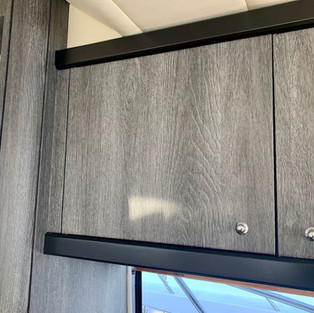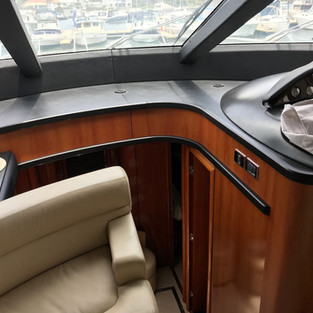Interior Vessel Vinyl Wood Grain Wrap to Fix Milky Wood Varnish and other issues
- IMC
- Sep 30, 2020
- 3 min read
Our team has been involved in the refurbishment using vinyl wraps on the inside of luxury vessels such as Sunseekers and other brands which has given the customer a huge choice of colour options to update the boat, and saved them a horrendous sum of money vs the traditional method of repair to boot.
VARNISH GONE MILKY WHITE IN PATCHES

Who knows the exact reason why some clear coat (varnish) goes milky over time. Some believe it is moisture, some believe it is UV exposure, but in our experience it has been unlikely to be either as we have seen wood veneered doors deep in vessels cabins that are affected one side of the room, but not on the other. If it was moisture, surely all would be affected. If it was UV, surely the backs of doors in the deepest darkest crew cabins would not be affected, and yet they are.
WOOD CHANGED COLOUR, GENERALLY LIGHTER

Some of the original timber surfaces have generally changed colour in the upper parts of the cabin where sun exposure has affected the timber and varnish causing it genera
lly become lighter, and now no longer matching other areas of wood surrounding including a mis-match of colour from the front of the door versus the back of cupboard doors.
CRACKING OF CLEAR COAT AND WATER DAMAGE

Of course there is also the possibility of discolouration due to water damaged from leaking windows and hatches. Sometimes this will lead to the water swelling
under the clear coat and then the clear coat will lift and crack, separating from the surface of the timber.
THE PROBLEM

While not a serious sea-worthiness problem, it unfortunately drags down the appearance and therefore value of a vessel if the interior wood is obviously discoloured, patchy, water damaged or cracked.
The real problem is the huge task of correcting the issue the traditional way with sanding and re-painting. Many of the items have been permanently fixed inside the vessel and significant damaged would incur if they were forcibly removed.
Items such as doors are easily removed, however, as one customer recently showed me on a door his friend had attempted to repair, one too many passes with the sander and the thin veneer will be compromised and the substrate starts to show through. The problem of then somehow sanding evenly and then painting in-situ of the items that cannot be removed then spray painting is very problematic and time consuming.
THE SOLUTION, OR AT LEAST A VERY GOOD OPTION
The IMC team has done several luxury vessels where we have offered and installed a solution by using the LG Hausys brand of architectural films that we import to Australia (website www.uniquevinyl.com.au), 3M DINOC vinyl, or Vvivid architectural vinyl.
How does this work? One of the films is selected to suit the look the owners are after, either trying to pick something close to the original, or by selecting a totally different look. Again, our product website www.uniquevinyl.com.au has a very good shop section showing the different vinyl finishes, however, nothing is as good as a real sample of the product which can be seen in a site meeting with us, or by ordering a product sample off the Unique Vinyl website.
Installation time can then vary depending on the size and complexity of the project, but the team will try to minimise the impact to you, and if requested we can make sure to work into your time schedule so your use of the vessel is not impacted.
Call or message us today if you have issues with your boat interior woods, or simply want to change the look and modernise the boat you love.
















































































































































































Comentários